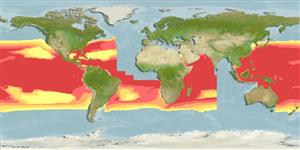>
Carangiformes (Jacks) >
Echeneidae (Remoras)
Etymology: Phtheirichthys: Greek, ptheiros, a fish that parasites other + Greek, ichthys = fish (Ref. 45335).
Environment: milieu / climate zone / depth range / distribution range
Écologie
marin; océanodrome (Ref. 51243); profondeur 0 - 5 m (Ref. 86942). Subtropical
Worldwide in tropical and subtropical waters. Western Atlantic: South Carolina, USA and northern Gulf of Mexico to northern South America (Ref. 7251). Western Central Pacific: Guam (Ref. 35720).
Taille / Poids / Âge
Maturity: Lm ? range ? - ? cm
Max length : 76.0 cm TL mâle / non sexé; (Ref. 2850)
Épines dorsales (Total) : 0; Rayons mous dorsaux (Total) : 32 - 38; Épines anales: 0; Rayons mous anaux: 31 - 38. Bluish black above, white below; 3 stripes along sides (upper pale blue, middle black, lower silvery).
Rare (Ref. 4389), oceanic species. Most often found attached to barracudas but also to other fishes and sea turtles. Clings to body of host and also found inside gill chambers.
Life cycle and mating behavior
Maturité | Reproduction | Frai | Œufs | Fécondité | Larves
Heemstra, P.C., 1986. Echeneidae. p. 662-664. In M.M. Smith and P.C. Heemstra (eds.) Smiths' sea fishes. Springer-Verlag, Berlin. (Ref. 4389)
Statut dans la liste rouge de l'IUCN (Ref. 130435: Version 2024-2)
Menace pour l'homme
Harmless
Utilisations par l'homme
Outils
Articles particuliers
Télécharger en XML
Sources Internet
Estimates based on models
Preferred temperature (Ref.
123201): 20.9 - 29.1, mean 26.9 °C (based on 39944 cells).
Phylogenetic diversity index (Ref.
82804): PD
50 = 1.0039 [Uniqueness, from 0.5 = low to 2.0 = high].
Bayesian length-weight: a=0.00257 (0.00110 - 0.00600), b=3.17 (2.96 - 3.38), in cm total length, based on LWR estimates for this (Sub)family-body shape (Ref.
93245).
Niveau trophique (Ref.
69278): 3.6 ±0.5 se; based on size and trophs of closest relatives
Résilience (Ref.
120179): Milieu, temps minimum de doublement de population : 1,4 à 4,4 années (Assuming Fec < 10,000).
Fishing Vulnerability (Ref.
59153): Moderate to high vulnerability (50 of 100).
